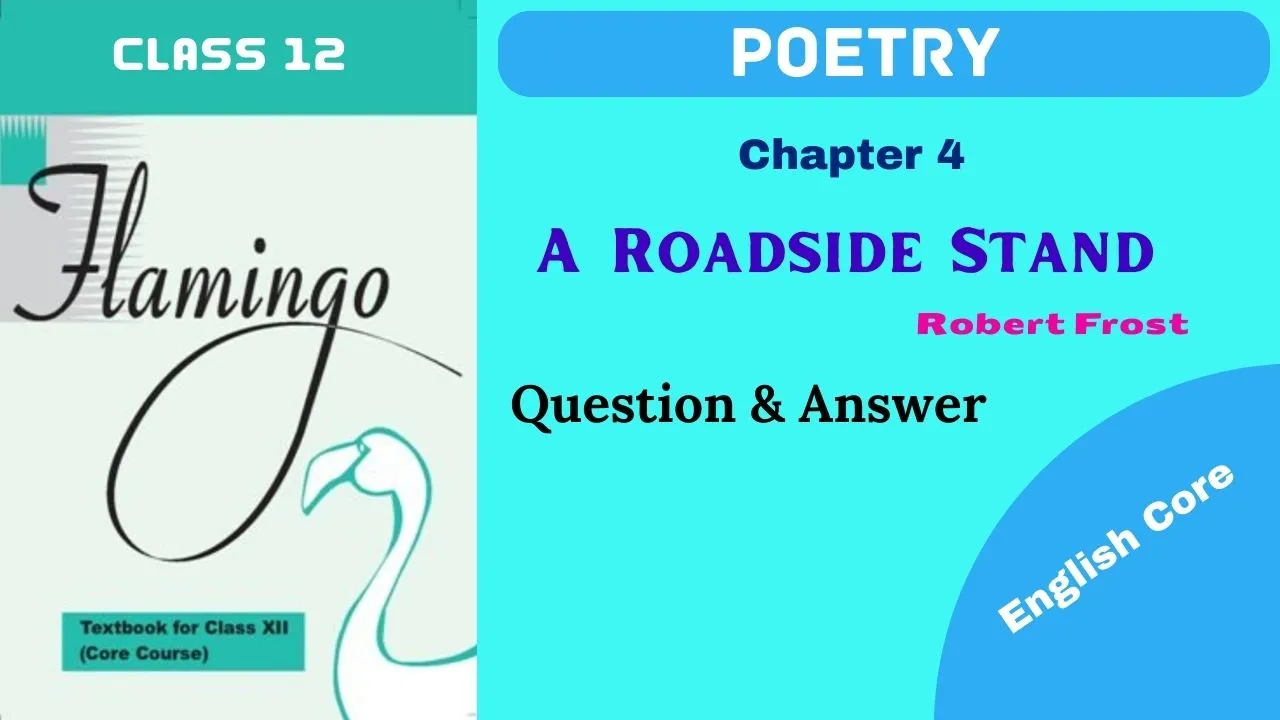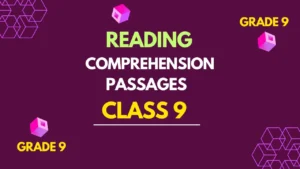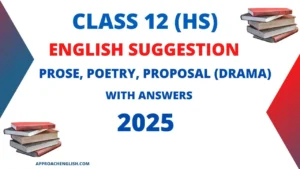The set of questions and answers for A Roadside Stand for CBSE Class 12 in 2024 serves as a valuable study resource for students. This guide includes essential Q&A based on NCERT and additional significant questions from the ‘Flamingo’ English textbook for Class XII (Core Course).”
Summary of A Roadside Stand by Robert Frost
“A Roadside Stand” by Robert Frost portrays a rural scene where a family sells goods by the roadside. The poem delves into the clash between traditional rural life and the advancing urban influence represented by passing cars. The static stand embodies stability and simplicity, while the dynamic movement of cars symbolizes modernity. Frost explores the tension between these contrasting elements, highlighting the impact of societal change on the rural landscape. The poem reflects on the evolving nature of American life, capturing the dichotomy between tradition and progress. Through vivid imagery and symbolism, Frost invites readers to contemplate the coexistence of these two worlds along a quiet roadside.
Translation
रॉबर्ट फ्रॉस्ट द्वारा लिखित “ए रोडसाइड स्टैंड” एक ग्रामीण दृश्य को चित्रित करता है जहां एक परिवार सड़क के किनारे सामान बेचता है। यह कविता पारंपरिक ग्रामीण जीवन और गुजरती कारों के बढ़ते शहरी प्रभाव के बीच टकराव पर प्रकाश डालती है। स्थिर स्टैंड स्थिरता और सरलता का प्रतीक है, जबकि कारों की गतिशील गति आधुनिकता का प्रतीक है। फ्रॉस्ट इन विरोधाभासी तत्वों के बीच तनाव की पड़ताल करते हुए ग्रामीण परिदृश्य पर सामाजिक परिवर्तन के प्रभाव पर प्रकाश डालते हैं। कविता अमेरिकी जीवन की विकसित प्रकृति को दर्शाती है, परंपरा और प्रगति के बीच द्वंद्व को पकड़ती है। ज्वलंत कल्पना और प्रतीकवाद के माध्यम से, फ्रॉस्ट पाठकों को एक शांत सड़क के किनारे इन दो दुनियाओं के सह-अस्तित्व पर विचार करने के लिए आमंत्रित करता है।
People also ask
Q4 A Roadside Stand class 12 Questions Answers MCQ Extract Based 1
Read the following extract and choose the correct option.
A No, in country money, the country scale of gain,
The requisite lift of spirit has never been found,
Or so the voice of the country seems to complain,
I can’t help owning the great relief it would be
To put these people at one stroke out of their pain.
And then next day as I come back into the sane,
I wonder how I should like you to come to me
And offer to put me gently out of my pain.
i The ‘country money’ contextually here refers to
a) money kept aside for the rural development.
b) wealth accumulated by the whole country.
c) meagre income earned by the countryside people.
d) riches collected by the ancestral farmers over time.
Ans: c) meagre income earned by the countryside people.
ii Pick the option that mentions elements justifying monetary aspect as the ‘requisite lift of spirit’.
1. confidence
2. ego
3. self-esteem
4. status
5. fame
a) 1, 2, 4
b) 2, 4, 5
c) 1, 3, 4
d) 1, 3, 5
Ans: d) 1, 3, 5
iii Choose the correct option with respect to the two statements given below.
Statement 1: The poet is agitated and depressed.
Statement 2: The poet realizes the futility of his thought about giving up.
a) Statement 1 can be inferred but Statement 2 cannot be inferred.
b) Statement 1 cannot be inferred but Statement 2 can be inferred.
c) Statement 1 and Statement 2 can be inferred.
d) Statement 1 and Statement 2 cannot be inferred.
Ans: b) Statement 1 cannot be inferred but Statement 2 can be inferred.
iv Choose the option that correctly paraphrases the given lines from the above extract. “I can’t help owning the great relief it would be To put these people at one stroke out of their pain.”
a) The poet wants to kill the impoverished people.
b) The poet feels that death is better than living such a miserable life.
c) The poet wants to eliminate poverty from the society.
d) The poet states that it is important that these people become rich.
Ans: b) The poet feels that death is better than living such a miserable life.
Q4 A Roadside Stand class 12 Questions Answers MCQ Extract Based 2
Read the following extract and choose the correct option.
B. The polished traffic passed with a mind ahead,
Or if ever aside a moment, then out of sorts
At having the landscape marred with the artless paint
Of signs that with N turned wrong and S turned wrong…
i The polished traffic in particular refers to the
a) sophisticated city dwellers in their vehicles.
b) shiny cars that the poet sees on the road.
c) extremely affluent people living in the neighbourhood.
d) civilized manner in which traffic is coordinated.
Ans: a) sophisticated city dwellers in their vehicles.
ii ‘The urban and educated people have their minds ahead.’
Choose the option suggesting the correct meaning behind this line.
| 1 The people are welleducated and knowledgeable about the condition of the poor. | 2 The people are concentrating on the road that is ahead in order to drive safely. |
| 3 The people are preoccupied only by the thoughts of the | 4 The people are focused on their goal of bettering the country. |
a) Option 1
b) Option 2
c) Option 3
d) Option 4
Ans: c) Option 3
iii What do the urban rich feel about the S and N signs that have been painted wrong?
a) Tolerant
b) Amused
c) Sympathetic
d) Annoyed
Ans: d) Annoyed
iv The passers-by find the sign artless but the landscape ___________.
a) animated
b) aesthetic
c) amusing
d) ancient
Ans: d) ancient
Q5 A Roadside Stand class 12 Questions Answers Stand Alone MCQs
Read the following extract and choose the correct option.
i Based on your reading of the poem, choose the option that correctly lays out the difference between the city-dwellers and the countryside people.
| City dwellers | Countryside people |
| Option 1• unaware • casual | • greedy • concerned |
| Option 2• indifferent • grumpy | • suffering • disappointed |
| Option 3• short-tempered • materialistic | • optimistic • savage |
| Option 4• stressed • dismissing | • protesting • objectionable |
a) Option 1
b) Option 2
c) Option 3
d) Option 4
Ans: b) Option 2
ii “I wonder how I should like you to come to me
And offer to put me gently out of my pain.”
The tone of the poem by the end, as depicted by the given lines is
a) frustrated.
b) commanding.
c) Introspective.
d) emotional.
Ans: d) emotional.
iii Pick the option with the slogan that is likely to be used by a person selling at the roadside stand.
| Slogan 1 | Slogan 2 | Slogan 3 | Slogan 4 |
| Men and women in equality; a road to dignity. | By the people and for the people. | I see humans but no humanity. | Corruption, corruption, you leave my country. That’s all I pray! |
a) Slogan 1
b) Slogan 2
c) Slogan 3
d) Slogan 4
Ans: c) Slogan 3
iv Choose the option that correctly categorizes the given literary devices as per the given analogy.
selfish cars : ……………. :: ………………. : metaphor
a) personification; polished traffic
b) transferred epithet; trusting sorrow
c) metaphor; pitiful kin
d) oxymoron; greedy good-doers
Ans: b) transferred epithet; trusting sorrow
v Choose the option that correctly mentions the complaints made by the poet through this poem.
1. The rich people drive carelessly on the road hitting the poor people on purpose.
2. The city-dwellers remain highly insensitive and offhand towards the poor people.
3. The urban people are unable to understand the struggles of the impoverished people.
4. The goods are not being bought by the wealthy people even at discounted rates.
a) 1, 2
b) 2, 3
c) 3, 4
d) 1, 4
Ans: b) 2, 3
Q10 A Roadside Stand class 12 Questions Answers in 30-40 words
i Though money holds the same value everywhere, the poet draws a distinction between city money and country money. Elaborate.
Ans: In “A Roadside Stand” by Robert Frost, the poet distinguishes between city money and country money to highlight the contrasting values and lifestyles of urban and rural settings. While the currency may be the same, the context and significance attached to money vary in the city and the countryside.
ii The roadside stand and the moving cars are a contrast around which the entire poem is woven. Expound.
Ans: In “A Roadside Stand” by Robert Frost, the static roadside stand and the passing cars create a striking contrast. The stand symbolizes permanence and rural simplicity, while the dynamic movement of cars represents urban transience. This sharp dichotomy forms the thematic core of the poem, exploring the clash between tradition and modernity.
iii Comment on the significance of the symbol of the car in the poem.
Ans: In “A Roadside Stand” by Robert Frost, the car serves as a powerful symbol of modernity and change. Its constant movement contrasts with the stationary roadside stand, embodying the intrusion of urban life into the rural landscape, reflecting the tension between tradition and progress.
iv Does the poet reach a conclusive solution for the issue at hand? Discuss.
Ans: “A Roadside Stand” by Robert Frost does not provide a conclusive solution to the tensions between tradition and modernity. Instead, the poem invites readers to contemplate the ongoing conflict between the static rural life represented by the stand and the dynamic urban influence symbolized by the passing cars.
Q12 A Roadside Stand class 12 Questions Answers in 120-150 words
i Imagine a car stops and actually buys from the roadside stand.
Keeping in mind the reaction you think the peasants would have, write a diary entry as the farmer describing not only your immediate experience but also your after-thoughts on being able to earn “city-money”.
You may begin this way:
Wednesday, 2nd March XX 9 PM
We had an unexpectedly good day today!…
Ans: Wednesday, 2nd March XX, 9 PM
We had an unexpectedly good day today! The sun dipped low on the horizon as we tended to the roadside stand, a familiar routine under the open sky. But then, a sleek car rolled to a stop, and city folks stepped out, eying our produce. To our amazement, they purchased generously. The jingle of city money echoed through the tranquil countryside, a sound as foreign as the hum of their engine.
After they left, we gathered around, marveling at the coins and bills in our calloused hands. The stand, once a humble outpost, now held the echoes of urban transactions. It stirred conflicting emotions – a mix of gratitude for the windfall and a quiet unease, wondering how the infusion of city money might alter the simplicity we’ve cherished for generations. Only time will unveil the impact of this unexpected encounter.
Farmer’s Diary
ii Imagine a child from the farmer’s family migrates to the city for their education. As the child, write back to your family telling them whether you would or would not want to turn into a city-person.
Use the context of the poem “A Roadside Stand” in mind to pen down this letter.
You may begin this way:
12, Davidson County
23 January ‘XX
Dear mom,
I have been thinking about the roadside stall lately. Now that I find myself surrounded by city-people all the time, I think……………………………………..
With love
Jennifer
Ans: 12, Davidson County
23 January ‘XX
Dear Mom,
I have been thinking about the roadside stall lately. Now that I find myself surrounded by city-people all the time, I think about the simplicity of our stand back home. The city is bustling with activity, a constant rush that I wasn’t accustomed to. Sometimes, amidst the towering buildings and busy streets, I yearn for the quietude of our countryside.
Yet, I can’t deny the opportunities here. The city has opened my eyes to a world of knowledge and possibilities. It’s challenging, but I believe in carrying our rural values with me. I wouldn’t want to become solely a city-person, but rather a bridge between the two worlds, bringing the best of both to our family.
With love,
Jennifer
Extra A Roadside Stand class 12 Questions Answers
What is the main point of the roadside stand?
Ans: The main point of the roadside stand in Robert Frost’s poem is its symbolic representation of the clash between rural simplicity and urban progress. It serves as a focal point for exploring the tension between tradition and the encroachment of modernity.
What is the central idea of the roadside stand questions and answers?
Ans: The central idea of the questions and answers related to “A Roadside Stand” by Robert Frost likely revolves around exploring the themes of tradition versus modernity, rural life, and the impact of societal change, as depicted in the poem.
Why do people at the roadside stand ask for city money?
Ans: In “A Roadside Stand” by Robert Frost, the request for city money reflects the economic challenges faced by those in rural areas. It symbolizes a desire for financial stability and an awareness of the changing economic dynamics between the countryside and the city.
What do the country people want roadside stand?
Ans: In “A Roadside Stand” by Robert Frost, the country people at the roadside stand seek city money, expressing a desire for economic prosperity. The transaction with city dwellers represents a yearning for financial stability and an acknowledgment of the changing economic dynamics between rural and urban life.
Why are the cars called selfish?
Ans: In “A Roadside Stand” by Robert Frost, the cars are metaphorically referred to as “selfish” because they seem indifferent and unconcerned about the impact they have on the rural landscape and the people at the roadside stand. Their relentless movement symbolizes urbanization’s disregard for traditional, slower-paced rural life.
Why rich people don t stop at the roadside stand?
Ans: In “A Roadside Stand” by Robert Frost, the poem suggests that rich people don’t stop at the roadside stand because they are more focused on their destination and the speed of their cars, emphasizing the disconnect between the affluent urban lifestyle and the simplicity of rural existence.
Who do selfish cars refer to?
Ans: In “A Roadside Stand” by Robert Frost, the term “selfish cars” is a metaphorical expression. It refers to the cars that pass by the roadside stand without stopping, embodying the idea of urbanization and modernity being self-absorbed and indifferent to the traditional, slower-paced rural life represented by the stand.
What is the meaning of withering faint?
Ans: In the context of “A Roadside Stand” by Robert Frost, the phrase “withering faint” could suggest a sense of decline or weakening. It may describe the diminishing presence or influence of the traditional rural lifestyle, as represented by the roadside stand, in the face of the advancing forces of urbanization.
Why do the roadside stand people have childish longing?
Ans: In “A Roadside Stand” by Robert Frost, the people at the roadside stand have a “childish longing” as they yearn for the city money. This reflects their innocent desire for economic stability and a better life, emphasizing the simplicity and purity of their aspirations.
Who are referred to as the flower of cities in a roadside stand?
Ans: In “A Roadside Stand” by Robert Frost, the term “flower of cities” refers to the bustling and thriving urban centers. The phrase conveys a sense of richness, prosperity, and cultural vibrancy associated with cities, especially in contrast to the simplicity of rural life depicted in the poem.
What does the poet pray for?
Ans: In “A Roadside Stand” by Robert Frost, the poet doesn’t explicitly mention praying, but he expresses a desire for a change in the flow of events. The poet seems to wish for a moment of pause or reflection amid the rapid urbanization symbolized by the passing cars at the roadside stand.
Why does the poet call the road open?
Ans: In “A Roadside Stand” by Robert Frost, the poet calls the road “open” to emphasize its accessibility and the unobstructed flow of traffic. Describing the road as open underscores its welcoming and expansive nature, highlighting the contrast with the static, enclosed setting of the roadside stand.
Why was the poet sorry?
Ans: In “A Roadside Stand” by Robert Frost, the poet refers to the road as “open” to emphasize its accessibility and the unobstructed flow of traffic. This description contributes to the contrast between the busy, open road and the static, enclosed nature of the roadside stand.
What kind of place is Innisfree?
Ans: In “A Roadside Stand” by Robert Frost, the poet expresses sorrow over the inevitable clash between the traditional, rural way of life represented by the roadside stand and the encroaching forces of urbanization symbolized by the passing cars. The sorrow stems from the tension and potential loss of the simplicity he observes.







